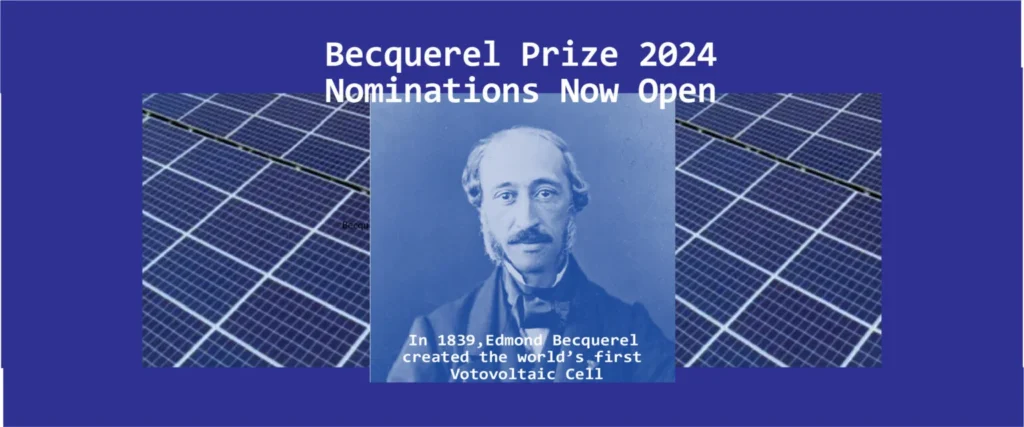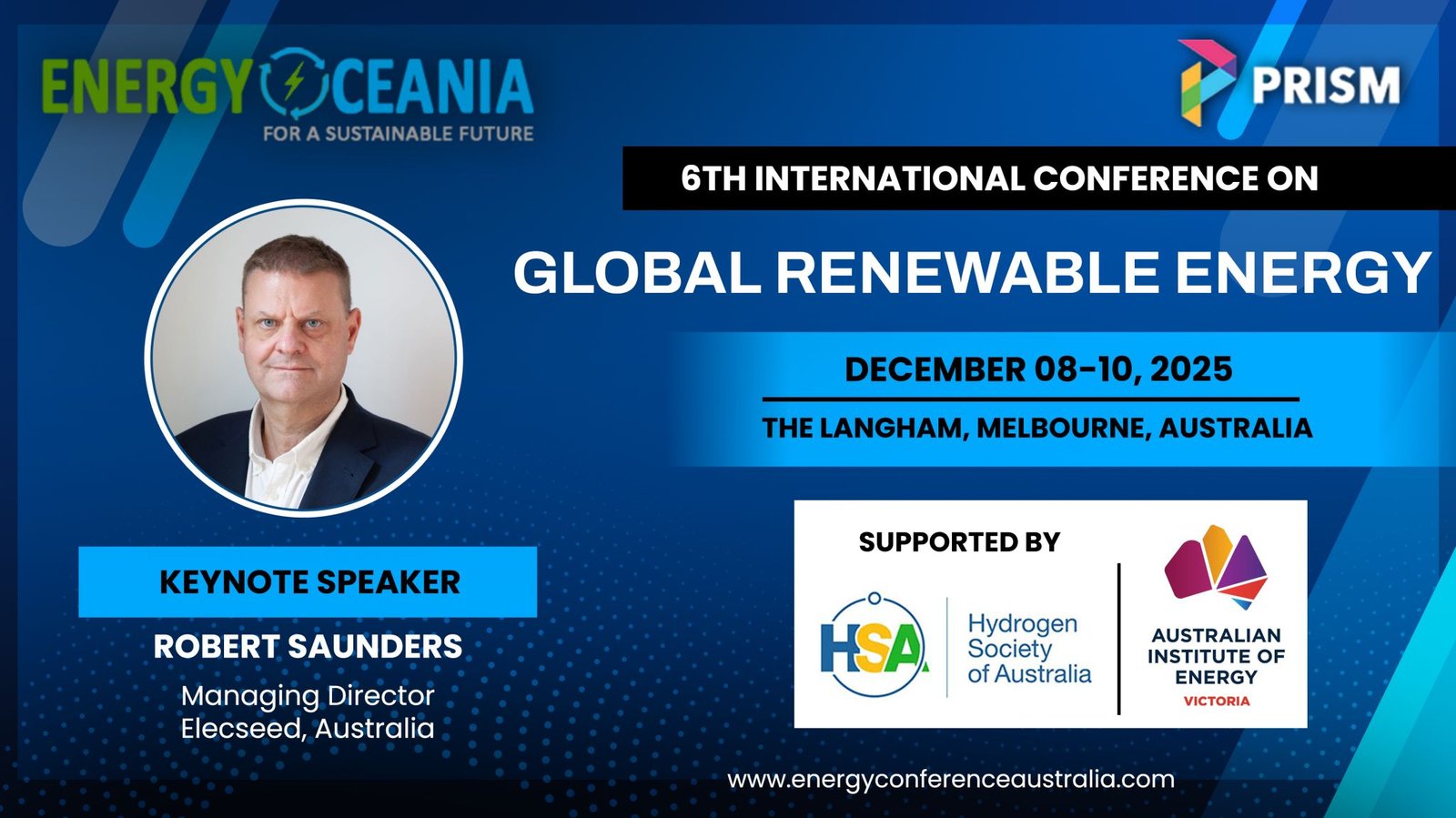“In this pivotal moment, as we stand at a crossroad. The golden concept discovered by Becquerel has evolved from obscurity to a beacon of hope. Our choices today will shape the fate of generations to come. Let us embrace the sun’s gift and steer our civilization toward a brighter, sustainable future.” (Noel Toumbourou- Contributor)
The Becquerel Prize 2024 nominations are now open from the global photovoltaics community and close on 13 May 2024. _________________________________________________________________________________________________________
In the archives of scientific discovery, some concepts shimmer like gold – brilliant. Yet, initially overlooked. Such is the case with the Photovoltaic effect- a phenomenon that would eventually revolutionise our world.
The Dawn of Photovoltaics
In 1839, at age 19, French scientist Edmond Becquerel first glimpsed at the potential of harnessing sunlight to generate electricity. Experimenting in his father’s laboratory, Becquerel created the world’s first photovoltaic cell. In this experiment, silver chloride or silver bromide was used to coat the platinum electrodes; once the electrodes were illuminated, voltage and current were generated. His discovery, however, remained dormant for decades due to the lack of practical applications.
The Bell Labs Breakthrough
Fast-forward to the 1950s, when scientists at Bell Laboratories turned their focus to photovoltaic (PV) technology. Armed with silicon, they crafted the first solar cells. By 1958, these cells were already powering satellites in space—an awe-inspiring feat.
A World of Fossil Fuels
Yet, the world was awash in cheap oil, gas, and coal. Industries wielded immense political influence, rendering the idea of widespread solar power economically and practically implausible. The finite nature of our environment barely registered—a mere footnote in the grand narrative.
A valuable history trajectory to where we are now: from ancient Babylon to the modern world, the discovery and utilization of these fossil fuels have shaped our societies, economies, and the very fabric of our existence.
Coal:
Ancient Origins: More than 4,000 years ago, natural asphalt (a form of solid fossil fuel) was used in the construction of the walls and towers of Babylon in today’s Iraq. Large quantities of it were found along the banks of the Issus River in Southern Turkey.
China’s Early Use: In China, petroleum was used over 2000 years ago whereby ancient Chinese writings, including the I Ching, mention the use of oil in its raw state without refining.
Oil and Gas:
James Young Discovery in 1847, a Scottish chemist, made a pivotal discovery. While observing the Riddings coal mine, he noticed natural petroleum seepage. From this seepage, he distilled both a light, thin oil suitable for lamps and a thicker oil suitable for lubrication. Hence, this started the modern oil and gas industries.
Abraham Pineo Gesner, approx 1847, a Canadian geologist, made a new discovery- Kerosene- from a process to refine a liquid fuel from coal, bitumen, and oil shale, which was a cleaner burn and more cost-effective than commonly used, whale oil.
Global Impact:
Nineteenth-Century Giants: While petroleum industries developed in several countries during the nineteenth century, the two dominant players were the United States and the Russian Empire (specifically the part that now forms independent Azerbaijan). Together, these nations produced 97% of the world’s oil during that era.
Automobiles and World Wars: The adoption of the internal combustion engine for automobiles and trucks around the turn of the twentieth century fueled explosive growth in the oil industry. Oil’s importance extended to military strategy during World War II when diesel fuel replaced steam engines in warships.
Energy Crises and Environmental Concerns: After coal’s dominance waned in the mid-1950s, oil gained significant media coverage. Its role in modern economies increased dramatically, but issues of air pollution led to government regulation. In the early twenty-first century, environmental concerns related to global warming from oil, gas, and coal made the industry politically controversial.
A History of Missteps
Post-WWII saw a surge of technological advancements, but not all were blessings. From the tragic Thalidomide episode to the Chornobyl disaster, humanity grappled with the consequences of its ingenuity. Meanwhile, vast dead zones marred our oceans, and the ozone layer bore a gaping wound caused by reckless chemicals- when diesel fuel replaced steam engines in warships.
The Turning Point
Amidst this tumultuous backdrop, I once assumed that vested interests would stifle any meaningful change. The monumental shift required to heal our planet seemed insurmountable. Yet, in 1987, the Montreal Protocol emerged—a beacon of hope. Nations rallied to address the ozone crisis, proving that collective action could mend our wounded Earth.
Facing the Heat
Today, we confront a new reality: human-induced planetary warming. Our very civilization, built on technological marvels, now threatens the delicate balance. Fossil fuels, once our lifeblood, have become our Achilles’ heel. But there’s a glimmer of hope—the inexorable rise of solar and wind power.
The Solar Renaissance
Driven not only by environmental urgency but also by economics, the renewable energy transition sector gains momentum. Solar and wind energy have become cost-competitive, outshining their fossil-based counterparts. As cities hum with life and comfort, we grapple with the overwhelming truth of climate change.
Geopolitical instability and the sheer change of attitudes and behaviours which have occurred over the last 12 months -of personal, regional, and countrywide energy security – will further reinforce the ‘will’ to move toward attractive reduced costs and Investment opportunities which are rapidly coming to the market and gathering momentum.
Nothing motivates business more than money – and now we see super disruption within the Motor Car and Transport Logistics industries- Electric Cars
With electric cars (EVs) destroying the old Automakers at a rate they never expected could happen, Oil power has run its race, with Tesla and BYD factories now smashing sales, well above even the biggest invincible Car Makers of ‘yesteryear’. The speed and momentum are mind-blowing…
Thomas Parker, an English inventor, built the first production EV in 1884. However, the first “real” electric car- more resembling today’s car- is credited to German engineer Andreas Flocken and his Flocken Elektrowagen, built-in 1888.
Mega EV factories in China, Mexico, the USA, and Europe are all vying for market share in launching their competitive designs – keeping in mind that under the bonnet is a very simple concept: an electric motor, battery, control system, and 4 wheels, contrary to Petrol cars, in which the mechanics are so complicated- and very expensive to replace parts.
1996 delivered the first modern electric vehicle (EV) by General Motors EV. But in 2008, the Tesler Roadster was the first to introduce and use lithium-ion battery technology, which is now the benchmark for all Auto competitors.
Green Hydrogen is on the horizon of possibly being the next EV auto-disrupter.
Contributor: Noel Toumbourou, a former residential property developer, a passionate advocate of saving our planet, living in harmony with nature, and being a responsible global citizen. Former property developer.















